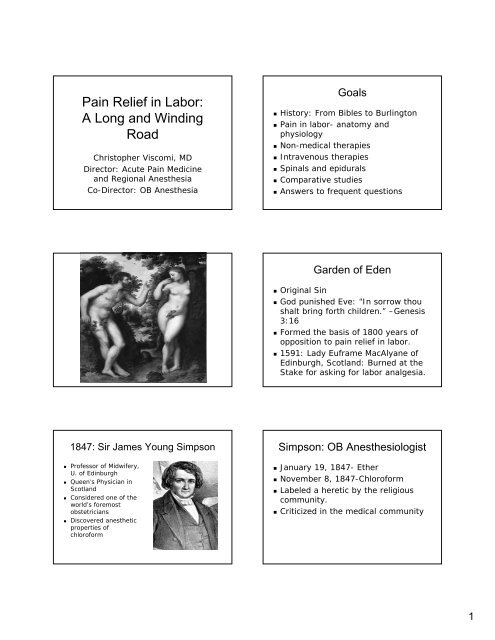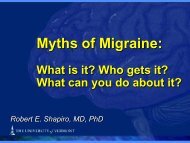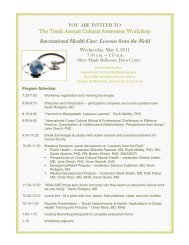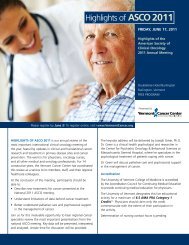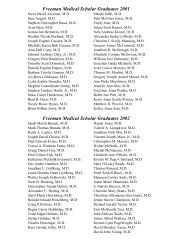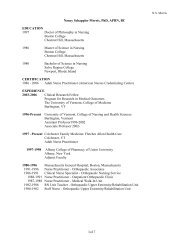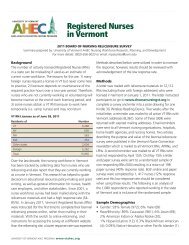Pain Relief in Labor: A Long and Winding Road
Pain Relief in Labor: A Long and Winding Road
Pain Relief in Labor: A Long and Winding Road
Create successful ePaper yourself
Turn your PDF publications into a flip-book with our unique Google optimized e-Paper software.
<strong>Pa<strong>in</strong></strong> <strong>Relief</strong> <strong>in</strong> <strong>Labor</strong>:<br />
A <strong>Long</strong> <strong>and</strong> W<strong>in</strong>d<strong>in</strong>g<br />
<strong>Road</strong><br />
Christopher Viscomi, MD<br />
Director: Acute <strong>Pa<strong>in</strong></strong> Medic<strong>in</strong>e<br />
<strong>and</strong> Regional Anesthesia<br />
Co-Director: OB Anesthesia<br />
Goals<br />
• History: From Bibles to Burl<strong>in</strong>gton<br />
• <strong>Pa<strong>in</strong></strong> <strong>in</strong> labor- anatomy <strong>and</strong><br />
physiology<br />
• Non-medical therapies<br />
• Intravenous therapies<br />
• Sp<strong>in</strong>als <strong>and</strong> epidurals<br />
• Comparative studies<br />
• Answers to frequent questions<br />
• Orig<strong>in</strong>al S<strong>in</strong><br />
Garden of Eden<br />
• God punished Eve: “In sorrow thou<br />
shalt br<strong>in</strong>g forth children.” –Genesis<br />
3:16<br />
• Formed the basis of 1800 years of<br />
opposition to pa<strong>in</strong> relief <strong>in</strong> labor.<br />
• 1591: Lady Euframe MacAlyane of<br />
Ed<strong>in</strong>burgh, Scotl<strong>and</strong>: Burned at the<br />
Stake for ask<strong>in</strong>g for labor analgesia.<br />
1847: Sir James Young Simpson<br />
• Professor of Midwifery,<br />
U. of Ed<strong>in</strong>burgh<br />
• Queen’s Physician <strong>in</strong><br />
Scotl<strong>and</strong><br />
• Considered one of the<br />
world’s foremost<br />
obstetricians<br />
• Discovered anesthetic<br />
properties of<br />
chloroform<br />
Simpson: OB Anesthesiologist<br />
• January 19, 1847- Ether<br />
• November 8, 1847-Chloroform<br />
• Labeled a heretic by the religious<br />
community.<br />
• Criticized <strong>in</strong> the medical community<br />
1
“In sorrow thou shalt br<strong>in</strong>g forth<br />
children” –Genesis 3:16<br />
• Simpson argued persuasively that<br />
“sorrow” was improperly translated.<br />
It was more properly “labor”, “toil”,<br />
or “physical exertion”.<br />
• Noted that God had permitted Adam<br />
to sleep when the rib was harvested<br />
to create women. Thus, clearly<br />
anesthesia was div<strong>in</strong>ely acceptable.<br />
Medical Opposition:<br />
Dr. Charles Meigs<br />
• American obstetrician of equal stature to<br />
Simpson.<br />
• Prom<strong>in</strong>ent New Engl<strong>and</strong> family.<br />
Descendents of Revolutionary War heroes,<br />
first governor of Ohio, <strong>and</strong> founder of the<br />
University of Georgia<br />
• “uter<strong>in</strong>e pa<strong>in</strong> is <strong>in</strong>separable from<br />
contractions. Any pa<strong>in</strong> relief dim<strong>in</strong>ishes<br />
contractions.”<br />
• “Pregnancy <strong>and</strong> labor are normal, <strong>and</strong><br />
should not be <strong>in</strong>terfered with powerful<br />
prescriptive drugs.”<br />
Meigs vs. Simpson<br />
• Simpson” “All pa<strong>in</strong><br />
is without<br />
physiologic value.<br />
It often degrades<br />
or destroys those<br />
who experience it.”<br />
• “it will be<br />
necessary to def<strong>in</strong>e<br />
the precise effect<br />
of ether on uter<strong>in</strong>e<br />
muscles.”<br />
1853: John Snow <strong>and</strong> Queen<br />
Victoria<br />
Snow <strong>and</strong> the London Cholera<br />
Epidemic: The Broad Street<br />
Pumphouse<br />
John Snow<br />
• Compatriot of James Simpson<br />
• Best know as the physician who solved the<br />
London Cholera epidemic<br />
• Cl<strong>in</strong>ical <strong>and</strong> research <strong>in</strong>terest <strong>in</strong><br />
anesthesia, particularly chloroform.<br />
• 4000 anesthetics from 1847-53, with only<br />
one death.<br />
• Secretly called to Buck<strong>in</strong>gham Palace by<br />
Queen Victoria for her delivery of Pr<strong>in</strong>ce<br />
Leopold<br />
2
The Fallout<br />
William Benson, Archbishop of<br />
Canterbury<br />
• The Lancet, Editor <strong>and</strong> Chief: “I<br />
cannot imag<strong>in</strong>e anyone could have<br />
advised the adm<strong>in</strong>istration of<br />
chloroform to her majesty dur<strong>in</strong>g a<br />
natural labor.”<br />
• The Royal Court denied the event for<br />
4 years until the birth of Pr<strong>in</strong>cess<br />
Beatrice <strong>in</strong> 1857. Chloroform was<br />
aga<strong>in</strong> adm<strong>in</strong>istered by Dr. Snow.<br />
Religious Acceptance<br />
1847 <strong>in</strong> America<br />
• 1855 Queen’s acceptance of “that<br />
blessed chloroform” for childbirth.<br />
• Archbishop of Canterbury's (leader of<br />
the Anglican/Episcopal Church)<br />
daughter receives chloroform for<br />
labor pa<strong>in</strong>s. He refuses to criticize<br />
her.<br />
Henry Wadsworth <strong>Long</strong>fellow<br />
• Famous poet <strong>and</strong> scholar.<br />
• His wife, Fanny Appleton <strong>Long</strong>fellow<br />
expect<strong>in</strong>g third child. She described her<br />
first two deliveries “excruciat<strong>in</strong>g<br />
suffer<strong>in</strong>g.”<br />
• Henry went to Dr. Nathan Keep, a Dean of<br />
Medic<strong>in</strong>e at Harvard, <strong>and</strong> developer of an<br />
etherization device.<br />
• Fanny’s “suffer<strong>in</strong>gs were greatly<br />
mitigated” “with no unpleasant<br />
symptoms”, “healthy girl”<br />
Fanny <strong>Long</strong>fellow<br />
• “I am sorry many thought me rash <strong>in</strong><br />
try<strong>in</strong>g the ether. I had heard such a<br />
th<strong>in</strong>g had succeeded abroad, where<br />
doctors apply this bless<strong>in</strong>g more<br />
boldly than our timid American ones.<br />
I feel proud to be a pioneer for less<br />
suffer<strong>in</strong>g for womank<strong>in</strong>d.”<br />
• “Gratitude, however, cannot be<br />
bestowed on those men who quarrel<br />
if this is a gift of God.”<br />
3
Mesmerism<br />
• “I have the idea of magnetiz<strong>in</strong>g a<br />
pregnant woman before delivery.<br />
Imag<strong>in</strong>e such a discovery as birth<br />
without pa<strong>in</strong>! Unfortunately Genesis<br />
doesn’t want this.” Dr. Grubert,<br />
Lyons, France, 1836<br />
• 1844, English Mesmerist JP Lynell<br />
provided a week of mesmerism<br />
culm<strong>in</strong>at<strong>in</strong>g <strong>in</strong> pa<strong>in</strong>less delivery.<br />
Mesmerism <strong>in</strong> America<br />
• Dr. William Fahnestock (Lancaster, PA)<br />
practiced “somnambulism”, which was<br />
similar to “animal magnetism” <strong>and</strong><br />
“mesmerism”, produc<strong>in</strong>g a “stuporous<br />
trance.”<br />
• Reported two deliveries managed without<br />
pa<strong>in</strong>. Mrs. Susan Herr had lost her<br />
eyesight <strong>and</strong> use of her legs with a<br />
previous pa<strong>in</strong>ful delivery. Sight, mobility,<br />
<strong>and</strong> pa<strong>in</strong>less labor were all obta<strong>in</strong>ed with<br />
“somnambulistic trance” dur<strong>in</strong>g her next<br />
delivery.<br />
Mesmerism vs. Ether<br />
• Mesmerists attempted hypnotic states for<br />
surgery, but were generally unsuccessful.<br />
• Famous British surgeon Sir Robert Liston<br />
proclaimed “This Yankee dodge (ether),<br />
gentlemen, beats mesmerism hollow!”<br />
• Never-the-less, for the last 160 years,<br />
hypnotic states have successfully achieved<br />
labor pa<strong>in</strong> relief.<br />
Dr. August Bier<br />
• University of Berl<strong>in</strong>, 1898<br />
• P<strong>in</strong>nacle of Western Medic<strong>in</strong>e <strong>in</strong><br />
1890s<br />
• He <strong>and</strong> an assistant (Dr. Henselbach)<br />
hammered sp<strong>in</strong>al needles <strong>in</strong>to each<br />
other backs, <strong>in</strong>jected coca<strong>in</strong>e.<br />
• Reported first sp<strong>in</strong>al anesthetic, first<br />
sp<strong>in</strong>al headaches.<br />
Description of Sp<strong>in</strong>al Anesthesia<br />
• “I ext<strong>in</strong>guished my cigar on<br />
Henselbach’s knee- it was sensed<br />
only as warmth.”<br />
• “I struck his sh<strong>in</strong> with an anvil, but<br />
no pa<strong>in</strong> was noted.”<br />
• “His testicle was placed <strong>in</strong> a surgical<br />
clamp. This evoked sweat<strong>in</strong>g <strong>and</strong><br />
some nausea, but no pa<strong>in</strong>.”<br />
4
Bier Footnotes<br />
• 1944: Mrs. Bier makes remark at<br />
Berl<strong>in</strong> cocktail party<br />
• Next day: both disappear. Mrs. Bier<br />
dies <strong>in</strong> prison 1945<br />
• Dr. Bier discovered confused, near<br />
starvation at <strong>in</strong>sane asylum, 1946<br />
1900: Sp<strong>in</strong>al anesthesia <strong>in</strong><br />
obstetrics<br />
• Dr. Oskar Kreis, University of Munich<br />
• First to use sp<strong>in</strong>al anesthesia for<br />
childbirth.<br />
• Technique generally used only for<br />
desperate surgical deliveries because<br />
of high rates of <strong>in</strong>fection <strong>and</strong> other<br />
complications.<br />
The poppy seed<br />
Opium<br />
• Available s<strong>in</strong>ce the Romans<br />
• Crude extracts from poppy seeds<br />
produced mixtures of morph<strong>in</strong>e,<br />
code<strong>in</strong>e, <strong>and</strong> opium<br />
• Taken orally, smok<strong>in</strong>g, or by<br />
smear<strong>in</strong>g seed paste on sk<strong>in</strong> followed<br />
by multiple puncture with a small<br />
knife.<br />
Syr<strong>in</strong>ge + Better chemistry =<br />
“Twilight sleep”<br />
• 1899: Von Ste<strong>in</strong>buchel’s <strong>and</strong> Gauss<br />
• Described comb<strong>in</strong><strong>in</strong>g morph<strong>in</strong>e with<br />
a plant extract (scopolam<strong>in</strong>e).<br />
• Amnesia was prom<strong>in</strong>ent, <strong>and</strong><br />
considered desirable.<br />
• Patient dem<strong>and</strong> exceeded physician<br />
endorsement, with most physicians<br />
oppos<strong>in</strong>g the practice.<br />
5
World War I<br />
• Great <strong>in</strong>term<strong>in</strong>gl<strong>in</strong>g of<br />
European <strong>and</strong><br />
American Medic<strong>in</strong>e<br />
• Post- war, obstetrics<br />
grew <strong>in</strong>to a<br />
scientifically advanced<br />
specialty<br />
• Effects of anesthesia<br />
on the newborn<br />
scientifically<br />
<strong>in</strong>vestigated<br />
Dr. Paul Zweifel,<br />
Demonstrated the presence of<br />
chloroform <strong>in</strong> newborn blood<br />
<strong>and</strong> ur<strong>in</strong>e.<br />
Twilight Sleep<br />
Virg<strong>in</strong>ia Apgar, MD<br />
• Caution urged: The Freiburg method<br />
of Dammerschlaf or twilight sleep.<br />
Am J. Obstet Gynecology, 1914<br />
• First reports of newborns breath<strong>in</strong>g<br />
slowly or not at all after mothers<br />
received “twilight sleep”.<br />
Apgar Score<br />
1950-70s: Contrast<strong>in</strong>g movements<br />
• First attempt to quantify<br />
effects of labor <strong>and</strong><br />
medications on the birth<br />
condition of the neonate.<br />
• Important to have person<br />
other than obstetrician or<br />
midwife do the score.<br />
• Allowed comparisons of<br />
pa<strong>in</strong> relief techniques:<br />
Sp<strong>in</strong>al anesthesia had<br />
better scores compared to<br />
general anesthesia.<br />
Grantly Dick-<br />
Read, MD<br />
Caudal-Epidural Injection<br />
6
Grantly Dick-Read: Natural<br />
Childbirth <strong>and</strong> Prenatal Education<br />
• English Gynecologist<br />
• Rejected the need for pa<strong>in</strong> reliev<strong>in</strong>g drugs<br />
dur<strong>in</strong>g childbirth: pa<strong>in</strong> was pr<strong>in</strong>cipally a<br />
product of preconceived fear <strong>and</strong> tension (<br />
he called it the 'fear-tension-pa<strong>in</strong>'<br />
syndrome). He believed that women who<br />
were properly prepared could control labor<br />
pa<strong>in</strong> themselves - without hav<strong>in</strong>g to resort<br />
to medication. In order to achieve this, he<br />
stressed the importance of education,<br />
exercise <strong>and</strong> relaxation.<br />
PART II: The Anatomy <strong>and</strong><br />
Physiology of <strong>Labor</strong> <strong>Pa<strong>in</strong></strong><br />
• Discrete nerve pathways for labor<br />
pa<strong>in</strong>.<br />
• Separate nerve fibers transmit pa<strong>in</strong><br />
form the uterus <strong>and</strong> from the vag<strong>in</strong>a.<br />
First Stage of <strong>Labor</strong><br />
• Onset of<br />
contractions until<br />
cervix fully dilated.<br />
• Uter<strong>in</strong>e<br />
contractions<br />
sensed <strong>in</strong> abdomen<br />
<strong>and</strong> back<br />
• Nerve fibers go<br />
from uterus to the<br />
sp<strong>in</strong>al cord (T10-<br />
L1).<br />
Second Stage of <strong>Labor</strong><br />
• Baby beg<strong>in</strong>s to<br />
descend <strong>in</strong>to<br />
vag<strong>in</strong>a<br />
• Distention of<br />
vag<strong>in</strong>a <strong>and</strong> rectal<br />
pressure<br />
transmitted via<br />
paired “pudendal<br />
nerves” <strong>in</strong>to the<br />
sp<strong>in</strong>al column <strong>in</strong><br />
the scrum.<br />
Transmission of <strong>Pa<strong>in</strong></strong> Signals<br />
From sensory nerve<br />
To Dorsal horn of<br />
Sp<strong>in</strong>al Cord<br />
To Sp<strong>in</strong>othalamic Track<br />
To Bra<strong>in</strong>stem<br />
To Thalamus<br />
To Cerebral cortex<br />
(conscious pa<strong>in</strong><br />
experience)<br />
7
Sp<strong>in</strong>al Cord<br />
<strong>Pa<strong>in</strong></strong> Control Options<br />
• First Stage of<br />
<strong>Labor</strong>:<br />
• Paracervical nerve<br />
block (rare)<br />
• Epidural/sp<strong>in</strong>al<br />
(common)<br />
• Narcotics<br />
• Non-pharmaco.<br />
(hypnosis, massage,<br />
breath<strong>in</strong>g techniques)<br />
• Second stage of<br />
labor:<br />
• Pudendal nerve<br />
block<br />
• Epidural/sp<strong>in</strong>al<br />
• Non-pharmacologic<br />
Pudendal <strong>and</strong> paracervical blocks<br />
Epidural<br />
Pudendal Nerve Block<br />
Paracervical Nerve block<br />
Part III: “Non-Medical Therapies”<br />
• Hypnosis- best studied<br />
• Education<br />
• Massage<br />
• Breath<strong>in</strong>g techniques<br />
• Water<br />
• Walk<strong>in</strong>g<br />
Hypnosis<br />
• Multiple theories of how it works,<br />
<strong>in</strong>clud<strong>in</strong>g altered neuro-transmitters,<br />
<strong>in</strong>creased natural narcotics<br />
(endorph<strong>in</strong>s), suppression of<br />
excitatory neurons.<br />
• Evidence is that it works well as an<br />
adjunct dur<strong>in</strong>g pa<strong>in</strong>ful surgical<br />
procedures.<br />
• Evidence is that it works well dur<strong>in</strong>g<br />
labor.<br />
8
Hypnosis as adjunct to m<strong>in</strong>or<br />
surgery<br />
Hypnosis for <strong>Pa<strong>in</strong></strong> <strong>Relief</strong> <strong>in</strong> <strong>Labor</strong><br />
<strong>and</strong> Childbirth: a Systematic<br />
Review<br />
• Br. J. Anaesth, 2004<br />
• 5 R<strong>and</strong>omized Cl<strong>in</strong>ical<br />
Trials, 3 of good quality<br />
• Results of these three<br />
comb<strong>in</strong>ed: “Metaanalysis”<br />
• Need for pa<strong>in</strong> relief<br />
drugs<br />
• Self rat<strong>in</strong>g of pa<strong>in</strong><br />
Hypnosis: Systematic review<br />
Hypnosis:<br />
Advantages/Disadvantages<br />
• 50% decrease <strong>in</strong> women request<strong>in</strong>g<br />
other analgesics<br />
• Of those choos<strong>in</strong>g narcotic <strong>in</strong>jection,<br />
they received less than non-hypnosis<br />
patients<br />
• Hypnosis patients rated their pa<strong>in</strong> as<br />
less severe compared to control<br />
patients<br />
• PROS:<br />
• No drugs<br />
• No allergic<br />
reactions<br />
• No needles<br />
• No placental drug<br />
transfer<br />
• Potential costsav<strong>in</strong>gs<br />
• Limitations<br />
• Patient<br />
commitment<br />
• Preparation:<br />
typically at least 6<br />
sessions<br />
• Hypnotist available<br />
• Substantial number<br />
still go on to<br />
receive IV drugs or<br />
epidural<br />
Education<br />
• Grantly Dick-Read stressed prenatal<br />
education as a key to less pa<strong>in</strong><br />
• Less fear=less pa<strong>in</strong><br />
• Scientific evidence is lack<strong>in</strong>g: no<br />
r<strong>and</strong>omized cl<strong>in</strong>ical trials.<br />
• Non-r<strong>and</strong>omized studies: lower pa<strong>in</strong><br />
scores <strong>and</strong> less analgesics if prenatal<br />
classes attended.<br />
Massage, Counter-pressure<br />
• No r<strong>and</strong>omized, placebo-controlled<br />
scientific study<br />
• No harm likely.<br />
• May have benefit<br />
9
• No prospective<br />
r<strong>and</strong>omized trial.<br />
• Multiple<br />
retrospective<br />
endorsements<br />
• Some controversy<br />
about low <strong>in</strong>itial<br />
Apgar scores with<br />
underwater births.<br />
Water birth<br />
• 2000+ years of use<br />
• Very simple to give:<br />
<strong>in</strong>travenous,<br />
<strong>in</strong>tramuscular, oral,<br />
through sk<strong>in</strong><br />
• Onset of effect rapid<br />
• Can be repeated as<br />
necessary<br />
• Can still get an<br />
epidural later<br />
Narcotics<br />
Downsides of narcotics<br />
• Limited pa<strong>in</strong> relief<br />
• Maternal sedation <strong>and</strong> nausea,<br />
neonatal effects<br />
• Predictor of need to “resuscitate” the<br />
newborn: Quadruples need<br />
• Reversal drug-naloxone+breath<strong>in</strong>g<br />
assistance. No difference by 6<br />
hours.<br />
My bias<br />
• Use narcotics very early <strong>in</strong> labor as a<br />
sleep aid.<br />
• “I just need a little help at the peaks<br />
of contractions, <strong>and</strong> a bit of rest <strong>in</strong>between<br />
contractions.”<br />
• Not for serious pa<strong>in</strong> relief, or those<br />
want<strong>in</strong>g a clear-headed recollection<br />
of labor.<br />
Epidural <strong>Labor</strong> Analgesia<br />
• I am an<br />
anesthesiologist.<br />
• The culture of<br />
above.<br />
• My pay does not<br />
change if you do or<br />
do not get an<br />
epidural dur<strong>in</strong>g<br />
your labor.<br />
Epidural <strong>Labor</strong> Analgesia<br />
• Pros:<br />
• The gold st<strong>and</strong>ard<br />
for pa<strong>in</strong> relief <strong>in</strong><br />
labor.<br />
• Alert mom<br />
• Compared to<br />
narcotics, greatly<br />
reduced newborn<br />
resuscitation rates.<br />
• Very high<br />
satisfaction<br />
• Cons:<br />
• Prolongs labor 1 hour<br />
• 15 more m<strong>in</strong>utes of<br />
push<strong>in</strong>g<br />
• 1% risk of headache<br />
• 1:23,000 risk of nerve<br />
<strong>in</strong>jury<br />
• Walk<strong>in</strong>g restricted<br />
• ?Bladder catheterized<br />
10
What do epidurals do to natural<br />
labor?<br />
• Very difficult to ethically exam<strong>in</strong>e.<br />
• It is unethical to r<strong>and</strong>omize women<br />
who want pa<strong>in</strong> relief to an epidural<br />
vs. a placebo.<br />
• Severe labor pa<strong>in</strong> predicts long labor<br />
<strong>and</strong> high chance of Cesarean<br />
delivery.<br />
• Large selection bias <strong>in</strong> observational<br />
studies<br />
Selection Bias<br />
• The undo<strong>in</strong>g of many research<br />
studies.<br />
• Observational <strong>and</strong> retrospective<br />
studies always have selection bias.<br />
• Prospective, R<strong>and</strong>omized, Placebo-<br />
Controlled, Double-Bl<strong>in</strong>d<strong>in</strong>g is best.<br />
The Cl<strong>in</strong>ical Significance of <strong>Pa<strong>in</strong></strong> <strong>and</strong><br />
Cognitive Activity <strong>in</strong> Latent <strong>Labor</strong><br />
• Wuitchik M, Bakal D, <strong>and</strong> Lipshitz J.<br />
Obstetrics <strong>and</strong> Gynecology 1989<br />
• 115 women, low risk, first<br />
pregnancy, <strong>in</strong> spontaneous labor<br />
• Psychological scor<strong>in</strong>g test for pa<strong>in</strong><br />
given dur<strong>in</strong>g latent phase of labor.<br />
• <strong>Pa<strong>in</strong></strong> scores categorized as<br />
“discomfort<strong>in</strong>g”, “distress<strong>in</strong>g”, <strong>and</strong><br />
“horrible/excruciat<strong>in</strong>g”<br />
Wuitchik, et al.<br />
• Epidurals not available<br />
• Completely observational study<br />
• Related pa<strong>in</strong> assessment <strong>in</strong> latent<br />
phase (early labor, cervical dilation<br />
< 5 cm) with duration of labor <strong>and</strong><br />
mode of delivery<br />
<strong>Pa<strong>in</strong></strong> <strong>and</strong> <strong>Labor</strong> Duration<br />
Phase Discomfort<strong>in</strong>g Distress<strong>in</strong>g Horrible/<br />
excruciat<strong>in</strong>g<br />
Latent 391 585 866<br />
Active 230 382 574<br />
Total 1 st<br />
Stage (m<strong>in</strong>)<br />
621 967 1440<br />
11
<strong>Pa<strong>in</strong></strong><br />
Intensity<br />
<strong>Pa<strong>in</strong></strong> <strong>and</strong> <strong>Labor</strong> Outcome<br />
Spontaneous Forceps Cesarean<br />
Discomfort<strong>in</strong>g 70.4% 29.6% 0.0%<br />
Distress<strong>in</strong>g 53.6% 39.3% 7.1%<br />
Horrible<br />
Excruciat<strong>in</strong>g<br />
31.6% 42.1% 26.3%<br />
Had epidurals been available…<br />
• The “horrible/excruciat<strong>in</strong>g” group<br />
was head<strong>in</strong>g for a long labor <strong>and</strong><br />
high chance of Cesarean delivery.<br />
• The Horrible/excruciat<strong>in</strong>g group<br />
would very likely have requested<br />
epidurals <strong>in</strong> great numbers <strong>in</strong> early<br />
labor.<br />
• If this had happened, then epidurals<br />
would have been blamed for long<br />
labors, C/S.<br />
Narcotics Vs. Epidural<br />
JAMA, 1998, Meta-analysis<br />
• All RCTs of epidural vs. narcotics <strong>in</strong> labor<br />
• Better pa<strong>in</strong> relief with epidural<br />
• Higher patient satisfaction with epidural<br />
• No change <strong>in</strong> Cesarean delivery rate.<br />
• 4x higher newborn resuscitation with<br />
narcotic<br />
• 1 hour longer total labor <strong>in</strong> 1 st pregnancy<br />
• More maternal fevers with epidural.<br />
• More “assisted” deliveries with epidural.<br />
When is “too early” to get an<br />
epidural?<br />
• What we know:<br />
• 3 RCTs<br />
• Women contract<strong>in</strong>g<br />
regularly, cervix<br />
dilat<strong>in</strong>g, > 2 cm<br />
• No advantage found <strong>in</strong><br />
wait<strong>in</strong>g until later <strong>in</strong><br />
labor for the epidural.<br />
• That is, if you are sure<br />
you want an epidural.<br />
When is too late?<br />
• No evidence-based response.<br />
• My experience with patients almost<br />
or completely dilated: 50%-50%<br />
• Can a person cooperate with the<br />
procedure?<br />
• Often a s<strong>in</strong>gle sp<strong>in</strong>al <strong>in</strong>jection is<br />
chosen.<br />
• Be well educated.<br />
• Listen to your<br />
body.<br />
• Be flexible <strong>in</strong> your<br />
plans.<br />
• Only get as much<br />
as you need.<br />
Part<strong>in</strong>g words<br />
12


